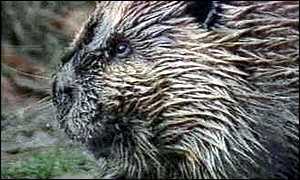
Backing for beaver's return
From BBC Scotland News 7 th February 2001
 A plan to return the beaver to the wild in Scotland has won the approval of those living near the trial site.
A plan to return the beaver to the wild in Scotland has won the approval of those living near the trial site.
Scottish Natural Heritage wants to re-introduce the animal to the wild, 400 years after it disappeared.
The government agency is seeking the go-ahead to release three families of beavers in Knapdale Forest, Argyll.
They would be electronically tagged and monitored as they move around Forestry Commission land.
Scottish Natural Heritage undertook a survey of people in the wider area of mid Argyll, who were asked for their views on the proposal.
Of the 59 responses received, 64% were in favour, 24% against and 12% did not express a clear opinion.
Forty people living in the immediate vicinity of the trial site responded, of whom 65% were in favour, 27.5% were against and 7.5% did not express a clear view.
The pilot study will only go ahead next year if it wins the approval of SNH's main board and is granted a licence by the Scottish Executive.
The project is also backed by Argyll and Bute Council, which sees benefits for tourism as well as wildlife.
However, some people remain concerned that beavers might damage salmon fisheries and could carry disease.
The beaver was hunted for its fur, its meat and a scent gland which was said to cure headaches.
A separate project to return the animal to the wild in England is also being planned, with conservationists seeking the go-ahead to place beavers in a 40-hectare (100-acre) enclosure in the Fens, East Anglia, later this year.
The Scottish project would take place over seven years, with the beavers imported from Norway.
Nancy Fraser of Scottish Natural Heritage said: "The animals would be flown over and quarantined. We would then tag them with radio transmitters and release them."
If the trial is successful, there are plans to introduce the creatures all over Scotland.
© BBC Scotland News, 7 th February 2001
 |
 |
 |
| Return to index | Return to Exotic Scottish Animals | Return to European Beaver |